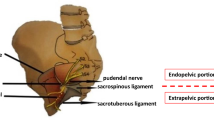Abstract
Introduction and hypothesis
Chronic perineal pain syndrome due to pudendal nerve impingement is difficult to diagnose and to treat. All the known treatment options leave room for improvement considering the outcome. Early neuromodulation of the pudendal nerve after its surgical release could improve outcomes.
Objectives
The aim of the study was to evaluate the potential beneficial effect of pudendal neuromodulation combined with release surgery using the ENTRAMI technique (endoscopic transgluteal minimally invasive technique).
Study design
This is a single-center prospective descriptive study. Between March 2019 and March 2020, 16 patients (2 males, 14 females) were included. Data were collected at baseline and 1 month after surgery.
Methods
Patients eligible for inclusion had chronic perineal pain for at least 3 months in the area served by the pudendal nerve. We combined pudendal nerve release with neuromodulation.
Results
At 1 month, the numeric pain rating scale (NPRS) dropped from 9.5 at baseline to 3.5 (p = 0.003). Seventy-six percent of patients showed a global impression of change (PGIC) of > 50% at 1 month, and optimal treatment response (PGIC ≥ 90%) was found in 41% of patients.
Limitations
The drawback of our study was that it was not randomized or blinded. The peripheral nerve evaluation lead (PNE) used could only be implanted for 1 month because of infection risk and is also prone to dislocations and technical failures.
Conclusion
Pudendal nerve liberation by the ENTRAMI technique combined with short-term pudendal neuromodulation seems feasible and promising in treating patients with chronic perineal pain.
Clinical trial number: NCT03880786.




Similar content being viewed by others
References
Tricard T, Munier P, Story F, et al. The drug-resistant pudendal neuralgia management: a systematic review. Neurourol Urodyn. 2019;38:13–21.
Robert R, Labat JJ, Bensignor M, et al. Decompression and transposition of the pudendal nerve in pudendal neuralgia: a randomized controlled trial and long-term evaluation. Eur Urol. 2005;47:403–8.
Possover M. Laparoscopic management of endopelvic etiologies of pudendal pain in 134 consecutive patients. J Urol. 2009;181:1732–6.
Erdogru T, Avci E, Akand M. Laparoscopic pudendal nerve decompression and transposition combined with omental flap protection of the nerve (Istanbul technique): technical description and feasibility analysis. Surg Endosc. 2014;28:925–32.
Beco J, Climov D, Bex M. Pudendal nerve decompression in perineology: a case series. BMC Surg. 2004;4:15.
Jottard K, Bonnet P, Bruyninx L, et al. The ENTRAMI technique: endoscopic transgluteal minimal invasive technique for implantation of a pudendal electrode under full visual control: a cadaver study. Neurourol Urodyn. 2019;38:130–4.
Heinze K, Hoermann R, Fritsch H, et al. Comparative pilot study of implantation techniques for pudendal neuromodulation: technical and clinical outcome in first 20 patients with chronic pelvic pain. World J Urol. 2015;33:289–94.
Peters KM, Killinger KA, Jaeger C, et al. Pilot study exploring chronic pudendal neuromodulation as a treatment option for pain associated with pudendal neuralgia. Low Urin Tract Symptoms. 2015;7:138–42.
Zhang X, Xin N, Tong L, et al. Electrical stimulation enhances peripheral nerve regeneration after crush injury in rats. Mol Med Rep. 2013;7:1523–7.
De Groote S, Goudman L, Peeters R, et al. Magnetic resonance imaging exploration of the human brain during 10 kHz spinal cord stimulation for failed back surgery syndrome: a resting state functional magnetic resonance imaging study. Neuromodulation. 2020;23:46–55.
Labat JJ, Riant T, Robert R, et al. Diagnostic criteria for pudendal neuralgia by pudendal nerve entrapment (Nantes criteria). Neurourol Urodyn. 2008;27:306–10.
Ploteau S, Robert R, Bruyninx L, et al. A new endoscopic minimal invasive approach for pudendal nerve and inferior cluneal nerve neurolysis: an anatomical study. Neurourol Urodyn. 2018;37:971–7.
Jottard K, Bruyninx L, Bonnet P, et al. A minimally invasive, endoscopic transgluteal procedure for pudendal nerve and inferior cluneal nerve neurolysis in case of entrapment: 3- and 6-month results. The ENTRAMI technique for neurolysis. Int J Color Dis. 2020;35:361–4.
Jottard K, Bruyninx L, Bonnet P, et al. Endoscopic trans gluteal minimal-invasive approach for nerve liberation (ENTRAMI technique) in case of pudendal and/or cluneal neuralgia by entrapment: one-year follow-up. Neurourol Urodyn. 2020;39:2003–7.
Bautrant E, de Bisschop E, Vaini-Elies V, et al. Modern algorithm for treating pudendal neuralgia: 212 cases and 104 decompressions. J Gynecol Obstet Biol Reprod (Paris). 2003;32:705–12.
Beco J, Seidel L, Albert A. Endoscopic transperineal pudendal nerve decompression: operative pudendoscopy. Surg Endosc. 2018;32:3720–31.
Author information
Authors and Affiliations
Corresponding author
Ethics declarations
Conflict of interest
None.
Additional information
Publisher’s note
Springer Nature remains neutral with regard to jurisdictional claims in published maps and institutional affiliations.
All authors approved the manuscript and this submission.
The ethics committee of the Centre Hospitalier Universitaire-Universitair verpleegcentrum Brugmann (CHU-UVC Brugmann) approved the protocol (EC number: CE2019/09).
Rights and permissions
About this article
Cite this article
Jottard, K., Bruyninx, L., Bonnet, P. et al. Pilot study: pudendal neuromodulation combined with pudendal nerve release in case of chronic perineal pain syndrome. The ENTRAMI technique: early results. Int Urogynecol J 32, 2765–2770 (2021). https://doi.org/10.1007/s00192-020-04565-1
Received:
Accepted:
Published:
Issue Date:
DOI: https://doi.org/10.1007/s00192-020-04565-1




